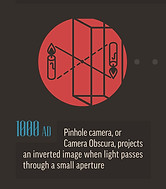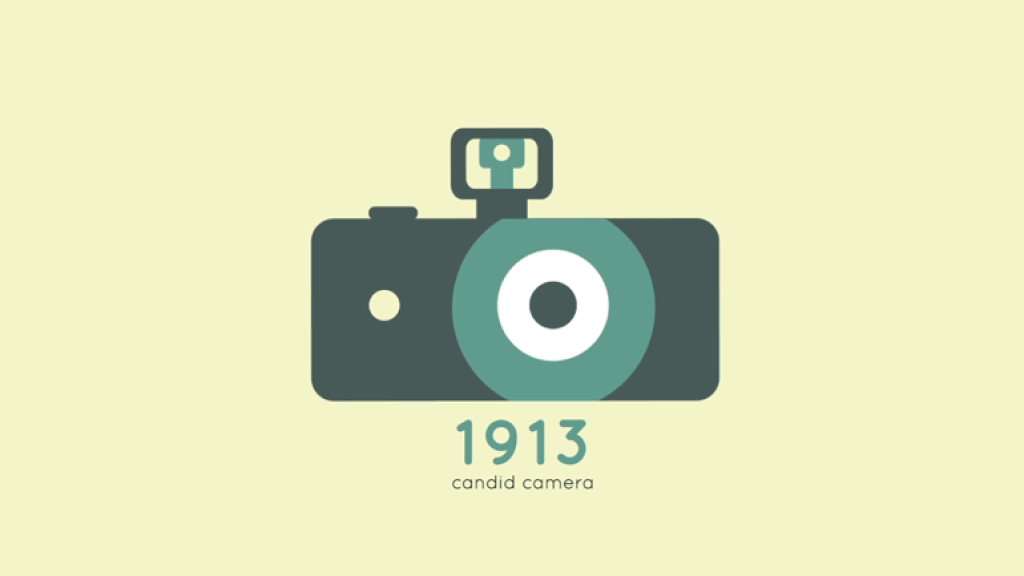















h I s t o r y o f
c o m m u n I c a t I o n
p r o j e c t
Camera
Photography has been an evolving form of communication for centuries. The camera as a major visual communication tool developed into an advanced article of technology since the beginning of photographic images. According to Masoner (2019), the basic concept of photography has been around since the 5th century B.C.E. however, it was not until an Iraqi scientist developed something called the camera obscura in the 11th century, that the art of photography was born. The first camera obscura utilized a pinhole in a tent to project from outside into a flat darkened area. Basic lenses to focus on the light were created around this time in the seventeenth century. Images were not recorded, but projected on a wall with a lighted lens and required skills of accurate drawing to trace and portray the image for a short period of time (Grundberg, Gernsheim, Newhall, & Rosenblum, 2019).
Although the concept of photography formed in the fifth century, it was not until the 1800s in France that the first permanent image and photograph was taken and created by Joseph Nicéphore Niépce. The success of Niépce’s first recorded image that did not fade quickly sparked a rapid progression of the form of photography. (Masoner, 2019) The transition into modern photography was developed by different early experiments and techniques. According to Bellis (2019), in 1727, German scientist named Johann Heinrich Schulze conducted the first experiments with photo-sensitive chemicals proving the silver salts were sensitive to light . His discoveries were prior to the first permanent photo invention, although, his experiments assisted in the discovery by Niépce an entire century after. Niépce used the experiments to create his own invention of placing an engraving on a metal plate coated in bitumen and exposure to light. The shadows of the engraving blocked light while exposing white areas that reacted with chemicals on the plate that when placed in a solvent gradually appeared an image. His experiment and discoveries were called heliographs which are often referred to as sun prints and are considered the first try at photographic images in the early 1800s. (Bellis, 2019).

Following the invention of heliography portraying permanent images, Louis Daguerre invented the first form of modern photography, known as daguerreotype. According to (Bellis, Biography of Louis Daguerre, Inventor of Daguerreotype Photography, 2019), “Louis Daguerre was a professional scene painter for the opera with an interest in lighting effects, and began experimenting with the effects of light upon translucent paintings in the 1820s. He became known as one of the fathers of photography.” He developed a partnership with Niépce and developed a process that stabilized images in under eight hours. After the death of Niépce, Daguerre continued to develop a more efficient method for photography. Due to a fortunate accident, he discovered a way to create more convenient and efficient photos through mercury vapor that sped the development of an image from eight hours to just thirty minutes. This process sparked inspiration and created more experiments to advance the visual effect of photography.
After the invention of the daguerreotype, many different types of processes to portray images were being experimented. Louis Daguerre’s work was shortly debuted into the public in 1839 after its successes and introduced photography to public masses. According to (Evolution of Cameras, 2019), “The cost and amount of time needed to produce such works were unreasonable for most working-class people. The speed of the camera, which only increased as time went on, made it possible for anybody to have quality portraits.” At the time the cameras were active in the public, they were mainly accessible to the higher classes. In 1888, camera film went on the market as the first Kodak cameras invented by George Eastman. They were a more affordable approach to photography than the film and daguerreotype styles. These cameras held up to 100 photos with the film inside and the entire device would be sent to a factory to be processed and printed. By the year 1900, the Brownie camera was invented utilizing the snapshot to the public. (Evolution of Cameras, 2019)

Through the formation and evolution of the brownie camera, different film sizes were created to produce different styles for photos. The camera became the first real “portable travel” camera ever to be invented. These inventions led to the idea and transition of instant cameras such as the Leica and polaroid camera. These types of cameras became available to the public and the quality of excellent photographs of the Leica camera became extremely popular in early 1900s. The easy usage and quick development of photos created a very popular item on the market at the time. (Tepfenhart, 2018). The polaroid camera began to evolve after World War II and became a popular and huge hit due to the instant film developed right out of the camera. By the 1960’s there were many models of polaroid on the market. (Masoner, 2019) The advancements led to compact film cameras often referred to as “point and shoot cameras”. These were cameras with strong image control in the 1970s and 80s that provided people to take automatic photos.
Through the development of compact cameras and the late 90s, cameras that stored images electronically were formed. These electric cameras used digital media rather than film when developing photos while still using the point and shoot method. In the 1980s, Sony created the first ever digital camera, but it was not a popular mass-produced technology due to impracticality and need of adjustments. (Tepfenhart, 2018)According to Masoner, (2019), “By 1991, Kodak had produced the first digital camera that was advanced enough to be used successfully by professionals. Other manufacturers quickly followed and today Canon, Nikon, Pentax, and other manufacturers offer advanced digital SLR (DSLR) cameras.”
Following the advancements of digital cameras, the first phone camera was created and invented by Samsung and released in South Korea in June of 2000. However, according to Hill, (2013)There’s a strong argument that the first real camera phone was produced by Sharp and released in Japan in November of 2000. These camera phones were adopted to the United States in 2002 and became a quickly popular trend by the end of the year 2003. Advancements evolving the phone camera have accelerated to better quality cameras as well as quicker results. Software advanced through phones and the cameras began to expand to more megapixels, creating clearer images and higher quality. As cell phones continue to progress such as Apple’s iPhone, the extent of the camera and capability of photography increases. (Hill, 2013)
The evolution of the camera and production of photography goes through many cycles to present day photography. Through advancements of light, composition, colors, film, digital media and camera quality and styles, the production of photography has advanced and evolved greatly over centuries. Photography has been a visual form of communication since the beginning of time; however, the technology has increased accessibility and quality of images. The camera is a communication technology that develops photography with a history of evolution to get to the present-day qualities of photography.

Bibliography
Bellis, M. (2019, August 22). Biography of Louis Daguerre, Inventor of Daguerreotype Photography. Retrieved from https://www.thoughtco.com/louis-daguerre-daguerreotype-1991565
Bellis, M. (2019, June 1). The History of Photography: Pinholes and Polaroids to Digital Images. Retrieved from https://www.thoughtco.com/history-of-photography-and-the-camera-1992331
Evolution of Cameras. (2019, February 6). Retrieved from Invention Land: https://inventionland.com/inventing/the-evolution-of-cameras/
Grundberg, Gernsheim, Newhall, & Rosenblum. (2019, 25 Jan). History of photography. Retrieved from Britannica: https://www.britannica.com/technology/photography#ref252839
Hill, S. (2013, August 11). From J-Phone to Lumia 1020: A complete history of the camera phone. Retrieved from Digital Trends: https://www.digitaltrends.com/mobile/camera-phone-history/
Masoner, L. (2019, 3 Jan). Retrieved from thesprucecrafts: https://www.thesprucecrafts.com/brief-history-of-photography-2688527
Tepfenhart, O. (2018). Photography. Retrieved from Vocal Media: https://vocal.media/photography/the-history-of-the-camera-how-each-camera-has-evolved
































